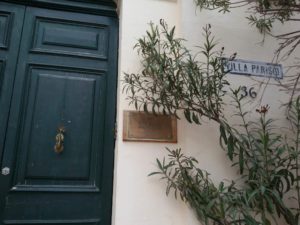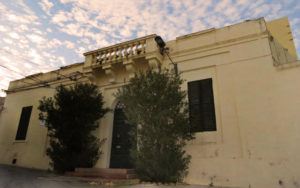Villa Parisio
Seat of the Strickland Foundation

Villa Parisio in Lija was a political and social hub during Miss Mabel Strickland’s lifetime. Tucked away in a quaint little square just off the Lija parish church, with a red oleander standing as sentinel on each side of the main door, Villa Parisio, a seventeenth century building, exudes history.
Pictures of her ancestors on the walls and a string of mementos conjure mental images of what life must have been like in the villa in her time – bustling and most exciting as service chiefs in uniform and politicians discussed public affairs with Miss Strickland over tea in the drawing room or in the patio overlooking orange groves.
Villa Parisio, where Miss Strickland lived for 45 years, has a history going back about 450 years. It belonged originally to the Muscati family. The family coat of arms, a field of azure with a lion rampant below a nutmeg tree, may be seen in the dining room above the door leading into the garden.
The Muscati family were a very old family in Lija. The first documented mention of the villa is found in 1567 when Simone Muscati, son of Giorgio, married Margherita Giugale. The villa was the Muscati family’s country house. Their town residence was Palazzo Parisio, now the Foreign Ministry building in Merchants Street, Valletta.
In 1702 the Noble Emmanuele Muscati, a direct descendant of Giorgio Muscati, married the Noble Margherita Sceberras. The villa and its olive grove are mentioned in an inventory of the family estate recorded that same year at the Castellania, where the law courts were at the time of the Sovereign Military Order of Malta. The Castellania now houses the health ministry.
On the death of Emmanuele Muscati in 1769, the property was divided between his children, and Villa Parisio went to one of his sons, Don Paolo Muscati, as part of his share of the estate. Don Paolo married the Noble Caterina Bonici in 1735. They had one daughter, Donna Anna, who became the heiress.
It is at this stage that the Parisios appear on the scene. They were a noble but impoverished family from Reggio Calabria in Italy. On October 13, 1760 Donna Anna Muscati married Don Domenico, eldest son of the House of Parisio and lived with her husband in Reggio.
The marriage was an unhappy one. Donna Anna had five children, the last one, Paolo Parisio, born in Malta. She left her husband and four of her children, bringing Paolo with her back to Malta to live in Villa Parisio.

Donna Anna died in 1797 and Villa Parisio was inherited by her fifth son, Paolo Parisio, a knight of the Sovereign Military Order of Malta. In that same year Cavaliere Paolo Parisio married his second cousin, Baroness Muscati Xara, daughter of Baron Emmanuele Muscati and Paola Gatt, who inherited her great-great-uncle, Baron Stanislaus Xara.
No children of the marriage between Cavaliere Paolo Parisio and Baroness Antonia Muscati survived. The Baroness married Sir Joseph De Piro, Baron of Budak as her second husband and made him universal heir on her death in 1856. Baron De Piro died in 1870 leaving his sister, Baroness Francesca De Piro as his heiress. She died in 1877.
The Parisio family in Malta thus became extinct in two generations on the death of Cavaliere Paolo Parisio. The property passed on to the De Piro family and remained in their ownership till the beginning of the twentieth century when the estate was divided and Villa Parisio was sold. It changed hands several times until Miss Strickland acquired it from Lady Strickland (Lord Strickland’s second wife) in 1943.
Miss Strickland lived at Villa Parisio till her death on November 29, 1988. Today, the villa is the seat of the Strickland Foundation and, quite appropriately, the street leading to it has been renamed after her.